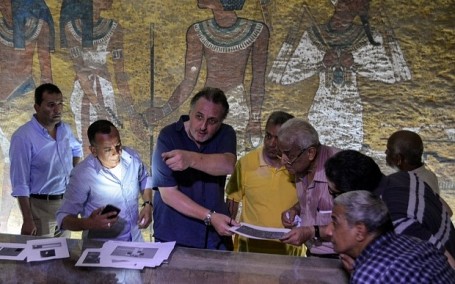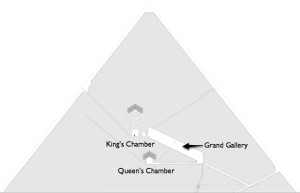Waiting for spring always feels like waiting a century in my book. At some point in the early weeks of the year (usually mid-January, after my birthday), winter becomes the worst, most awful season. The holidays are over, the snow becomes slushy and dirty, the cold becomes unbearable, and there is nothing to look forward to but the sweet, sweet sound of the birds chirping in the early hours of the morning. But has spring fully come? If you live in New York, it’s a week of spring, then a week of summer, back to winter for 2 weeks, and THEN hopefully spring is here for good and humanity feels suddenly optimistic, again.
The ancient Egyptians experienced a similar waiting period during the annual Nile flood. The Egyptian seasonal calendar corresponded with the flooding of the Nile; Akhet (Flooding season) from June to September**, consisted of the months Thoth, Paophi, Athyr, and Khoyak; Peret (Growing season) from October to February** with Tybi, Mekhir, Phamenat, and Pharmuti; and Shemu (Harvesting Season), from March to May** with months Pakhons, Payni, Epiphi, and Mesore.
The beginnin g of the inundation, and the Egyptian New Year, began when Sirius, the “Dog Star” (Sopdet in ancient Egyptian), started to rise in the sky. In the first season of the year, Akhet, the Nile rose considerably, putting miles upon miles of Egyptian farmland under roughly 5 feet of water. Egyptians developed a way to manage the flood known as basin irrigation, which allowed them to semi-control the rise and fall of the river. A crisscross network of walls was formed in each field, and when the floods came, the water would be trapped in the basins formed by the walls. This allowed the grid to hold water longer than it would have in the natural Nile flood, and further allowed the soil to become fully saturated in order to provide strong crops.
g of the inundation, and the Egyptian New Year, began when Sirius, the “Dog Star” (Sopdet in ancient Egyptian), started to rise in the sky. In the first season of the year, Akhet, the Nile rose considerably, putting miles upon miles of Egyptian farmland under roughly 5 feet of water. Egyptians developed a way to manage the flood known as basin irrigation, which allowed them to semi-control the rise and fall of the river. A crisscross network of walls was formed in each field, and when the floods came, the water would be trapped in the basins formed by the walls. This allowed the grid to hold water longer than it would have in the natural Nile flood, and further allowed the soil to become fully saturated in order to provide strong crops.
By October the flood waters would recede, and the growing season Peret would begin. This was the busiest season for ancient Egyptian farmers, requiring them to plough with both hand ploughs pulled by oxen, preparing the soil for the laying of the seeds. Farmers planted a number of crops including wheat, barley, flax, onions, figs, plums, melons, etc. into the newly ploughed soil, with goats or other animals following behind, their hooves pushing the seeds into the ground.
 After all the crops had reached full growth, Shemu began. No plant was left unharvested! Grain was cut using sickles, tied into bundles, and carried away; wheat was made into bread, barley into beer, and flax used to make linen cloth; even the papyrus reeds that grew naturally along the Nile banks were harvested to make sandals, baskets, mats, and paper. Women and children often helped during harvesting seasons—the children leaving school—to make certain that the crops were fully harvested and accounted for. Finally, the crops were sold or given to the pharaoh as tribute.
After all the crops had reached full growth, Shemu began. No plant was left unharvested! Grain was cut using sickles, tied into bundles, and carried away; wheat was made into bread, barley into beer, and flax used to make linen cloth; even the papyrus reeds that grew naturally along the Nile banks were harvested to make sandals, baskets, mats, and paper. Women and children often helped during harvesting seasons—the children leaving school—to make certain that the crops were fully harvested and accounted for. Finally, the crops were sold or given to the pharaoh as tribute.
During Shemi, a great festival to the god Hapi was held, in hopes that Hapi, god of the Nile, would bless them with a good upcoming flood, and ensure a bountiful harvest the next year.
Then the cycle would begin again, and this, I imagine, is when the ancient Egyptians would have experienced their version of “winter fatigue.” At first, they would be incredibly happy that the flood season had arrived and that the hardest work was over for a few months, then, after just a few short weeks, they would be “so absolutely over” traveling everywhere in boats that they would be praying for the busy harvest time to arrive again.
So, as we eagerly await the day when spring will stick for good, I’ll be grateful that at least I don’t have to travel all over New York City by boat….at least not yet.

**: Any alignment with our modern months is based on references to a combination of multiple sources and should NOT be taken as fact. Remember, one of the most fascinating (and frustrating) things about Egyptology is that we could be totally wrong about EVERYTHING.
Works Cited
http://www.ancientegyptonline.co.uk/calendar.html
http://thepharaohsmag.blogspot.com/2013/06/ancient-egyptian-seasons.html#.Vsx0ZvkrK70





























Recent Comments